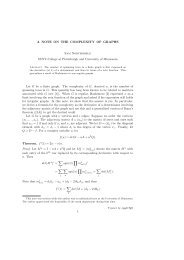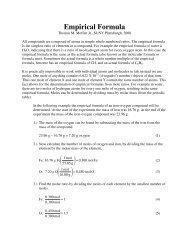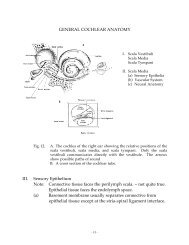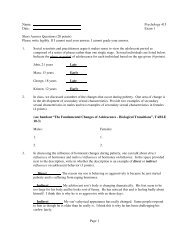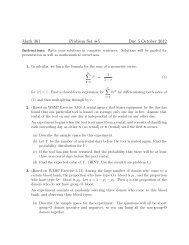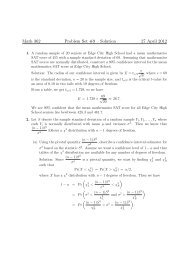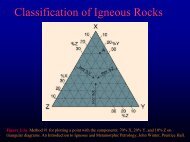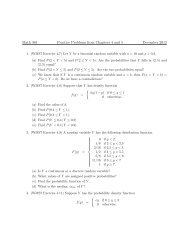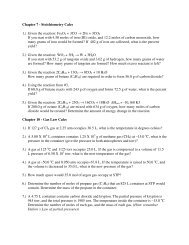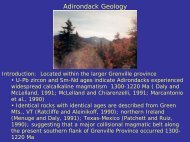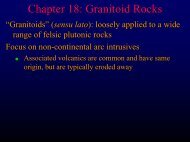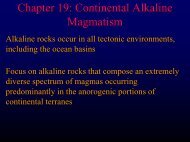Chapter 17: Continental Arcs - Faculty web pages
Chapter 17: Continental Arcs - Faculty web pages
Chapter 17: Continental Arcs - Faculty web pages
You also want an ePaper? Increase the reach of your titles
YUMPU automatically turns print PDFs into web optimized ePapers that Google loves.
<strong>Chapter</strong> <strong>17</strong>: <strong>Continental</strong> Arc Magmatism<br />
Potential differences with respect to Island <strong>Arcs</strong>:<br />
<br />
Thick sialic crust → more pronounced effects of<br />
contamination<br />
<br />
Low density of crust may retard ascent<br />
stagnation of magmas<br />
more potential for differentiation<br />
<br />
Low melting point of crust allows for partial melting<br />
and crustally-derived melts
<strong>Continental</strong> Magmatic <strong>Arcs</strong><br />
Common characteristic – mixture of rock types<br />
• basalt and rhyolite<br />
• called bimodal volcanism<br />
Direct result of magma interactions w/thicker continental<br />
crust<br />
Tendency to explosive activity<br />
•High SiO 2 content<br />
•High viscosity<br />
•Increase in H 2 O content<br />
•Gas expansion during low P boiling of H 2 O
<strong>Continental</strong> Magmatic <strong>Arcs</strong><br />
Batholiths – peculiar to continental margins<br />
• Enormous, 10s to 100s thousands of km 2<br />
Composed of 100s of individual plutons<br />
•Called granite but actually dominated by<br />
granodiorite, tonalite and qtz diorite
Petrography of continental arc volcanics<br />
Andesites – phenocryst-rich<br />
rich<br />
• strongly zoned plagioclase often with sieve texture<br />
• partially resorbed hydrous minerals such as biotite and<br />
hornblende<br />
• Oxidation forms fine-grained magnetite in irregular outer<br />
margin of resorbed xstals<br />
Intrusive rocks – dominated by plagioclase, K-feldspar, K<br />
qtz,<br />
biotite, , and hornblende<br />
•Granodiorite, tonalite, , diorite
<strong>Chapter</strong> <strong>17</strong>:<br />
<strong>Continental</strong> Arc<br />
Magmatism<br />
Figure <strong>17</strong>-1. Map of western South America showing<br />
the plate tectonic framework, and the distribution of<br />
volcanics and crustal types. NVZ, CVZ, and SVZ are<br />
the northern, central, and southern volcanic zones.<br />
After Thorpe and Francis (1979) Tectonophys., 57, 53-<br />
70; Thorpe et al. (1982) In R. S. Thorpe (ed.), (1982).<br />
Andesites. Orogenic Andesites and Related Rocks. John<br />
Wiley & Sons. New York, pp. 188-205; and Harmon et<br />
al. (1984) J. Geol. Soc. London, 141, 803-822. Winter<br />
(2001) An Introduction to Igneous and Metamorphic<br />
Petrology. Prentice Hall.
<strong>Chapter</strong> <strong>17</strong>:<br />
<strong>Continental</strong> Arc<br />
Magmatism<br />
Figure <strong>17</strong>-2. Schematic diagram to<br />
illustrate how a shallow dip of the<br />
subducting slab can pinch out the<br />
asthenosphere from the overlying<br />
mantle wedge. Winter (2001) An Introduction to<br />
Igneous and Metamorphic Petrology. Prentice Hall.
<strong>Chapter</strong> <strong>17</strong>: <strong>Continental</strong> Arc Magmatism<br />
Figure <strong>17</strong>-9. Relative frequency of rock types in the Andes vs. SW Pacific Island arcs. Data from 397 Andean and 1484 SW Pacific<br />
analyses in Ewart (1982) In R. S. Thorpe (ed.), Andesites. Wiley. New York, pp. 25-95. Winter (2001) An Introduction to Igneous and<br />
Metamorphic Petrology. Prentice Hall.
<strong>Chapter</strong> <strong>17</strong>:<br />
<strong>Continental</strong> Arc<br />
Magmatism<br />
Figure <strong>17</strong>-10. Map of the Juan de Fuca<br />
plate-Cascade Arc system, after<br />
McBirney and White, (1982) The<br />
Cascade Province. In R. S. Thorpe (ed.),<br />
Andesites. Orogenic Andesites and Related Rocks.<br />
John Wiley & Sons. New York. pp. 115-136. Also<br />
shown is the Columbia Embayment<br />
(the western margin of pre-Tertiary<br />
continental rocks) and approximate<br />
locations of the subduction zone as it<br />
migrated westward to its present<br />
location (after Hughes, 1990, J.<br />
Geophys. Res., 95, 19623-19638). Due to<br />
sparse age constraints and extensive<br />
later volcanic cover, the location of the<br />
Columbia Embayment is only<br />
approximate (particularly along the<br />
southern half). Winter (2001) An Introduction<br />
to Igneous and Metamorphic Petrology. Prentice<br />
Hall.
<strong>Chapter</strong><strong>17</strong>: <strong>Continental</strong><br />
Arc Magmatism<br />
a. Initial state<br />
• Destructive Boundary – trench<br />
migrates toward continent<br />
• Constructive Boundary – trench<br />
migrates away from continent<br />
Figure <strong>17</strong>-11. Schematic cross sections of a volcanic<br />
arc showing an initial state (a) followed by trench<br />
migration toward the continent (b), resulting in a<br />
destructive boundary and subduction erosion of the<br />
overlying crust. Alternatively, trench migration away<br />
from the continent (c) results in extension and a<br />
constructive boundary. In this case the extension in (c)<br />
is accomplished by “roll-back” of the subducting<br />
plate. An alternative method involves a jump of the<br />
subduction zone away from the continent, leaving a<br />
segment of oceanic crust (original dashed) on the left<br />
of the new trench. Winter (2001) An Introduction to Igneous and<br />
Metamorphic Petrology. Prentice Hall.
<strong>Chapter</strong> <strong>17</strong>: <strong>Continental</strong> Arc Magmatism<br />
Juan de Fuca-North<br />
American plate convergence<br />
rates for the past 35 Ma.<br />
(Verplanck and Duncan, 1987 Tectonics, 6, 197-209)<br />
Figure <strong>17</strong>-12. Time-averaged<br />
rates of extrusion of mafic<br />
(basalt and basaltic andesite),<br />
andesitic, and silicic (dacite and<br />
rhyolite) volcanics (Priest, 1990, J.<br />
Geophys. Res., 95, 19583-19599) .<br />
The volcanics are poorly<br />
exposed and sampled, so the<br />
timing should be considered<br />
tentative. Winter (2001) An<br />
Introduction to Igneous and Metamorphic<br />
Petrology. Prentice Hall.
<strong>Chapter</strong> <strong>17</strong>: <strong>Continental</strong> Arc<br />
Magmatism<br />
Figure <strong>17</strong>-15a. Major plutons of the North<br />
American Cordillera, a principal segment<br />
of a continuous Mesozoic-Tertiary belt<br />
from the Aleutians to Antarctica.<br />
After Anderson (1990, preface to The Nature and Origin of Cordilleran<br />
Magmatism. Geol. Soc. Amer. Memoir, <strong>17</strong>4. The Sr 0.706 line in N.<br />
America is after Kistler (1990), Miller and Barton (1990) and Armstrong<br />
(1988). Winter (2001) An Introduction to Igneous and Metamorphic<br />
Petrology. Prentice Hall.
<strong>Chapter</strong> <strong>17</strong>: <strong>Continental</strong> Arc<br />
Magmatism<br />
Figure <strong>17</strong>-15b. Major plutons of the South<br />
American Cordillera, a principal segment of<br />
a continuous Mesozoic-Tertiary belt from<br />
the Aleutians to Antarctica. After USGS.
Petrogenesis of continental arc magmas<br />
• Complex, multi-source,<br />
multi-stage<br />
• Origin – peridotites of<br />
mantle wedge<br />
• Melting induced by<br />
addition of LIL-enriched<br />
fluids from subducting slab<br />
• Primary magma = olivine<br />
tholeiite basalt<br />
• Pond at base of thick cont<br />
crust and undergo<br />
fractional xstallization,<br />
assimilation, and melting of<br />
lower crustal rocks<br />
Figure <strong>17</strong>-23. Winter (2001) An Introduction to Igneous and Metamorphic<br />
Petrology.
Differences between continental arc and island arc volcanics<br />
1. Sub-continental<br />
lithospheric mantle (SCLM) – different from<br />
oceanic lithosphere<br />
Anchored to overlying continent since formation<br />
Xenoliths from kimberlites suggest SCLM locally enriched during<br />
its stagnation beneath continent<br />
Enriched mantle becomes part of subduction zone wedge<br />
2. MASH – various combinations of melting, assimilation, storage<br />
and homogenization at base of crust<br />
Great deal of magma xstallizes at base of crust adding to it in<br />
process called underplating<br />
3. <strong>Continental</strong> arc magmas – biased toward more siliceous magmas<br />
w/higher concentrations of K 2 O, Rb, , Cs, Ba, Th and LREE and<br />
more enriched isotopes<br />
Correlates w/presence of thick continental crust
Differences between continental arc and island arc volcanics<br />
Old re-enriched<br />
enriched subcontinental lithospheric mantle contributes to<br />
enrichment of continental magmatic arcs<br />
4. Plutonic rocks more evolved than volcanics – voluminous<br />
tonalites, monzonites and granites w/lesser amounts of gabbros and<br />
qtz diorites<br />
5. Combination of mantle-derived melting that solidified before<br />
reaching surface and remelts of mafic magmas that solidified as<br />
crustal underplates<br />
6. <strong>Continental</strong> arc sources include: subducted oceanic crust and<br />
sediments, mantle wedge, heterogeneous continental crust,<br />
crustal underplates and sub-continental<br />
lithospheric mantle



